Abstract
The pathogenesis of the wide-spectrum human disease caused by Salmonella species is poorly understood. Cytotoxin production by other enteric pathogens has been increasingly investigated recently, and data are accumulating regarding the role of cytotoxins in enteric infections and hemolytic uremic syndrome. We studied the cytotoxic activity of 131 Salmonella strains of the major serotypes, including 94 strains of Salmonella enteritidis, 12 strains of Salmonella typhi, and 25 strains of Salmonella choleraesuis. Cytotoxicity was quantitatively determined in sonic extracts by a [3H]thymidine-labeled HeLa cell assay. All Salmonella strains examined showed some degree of cytotoxic activity. The geometric means +/- standard deviations of the amounts of cytotoxin produced (50% cytotoxic dose per milligram of bacterial protein) were 27 +/- 2 for S. typhi, 65 +/- 2 for S. enteritidis, and 117 +/- 2 for S. choleraesuis. Analysis of variance showed that the differences in cytotoxin production by the three species were significant (P less than 0.001). No significant differences were found between stool isolates and invasive strains of the same species. Neutralization studies showed that the cytotoxins produced by all Salmonella strains were immunologically distinct from Shiga toxin and the closely related Shiga-like toxins produced by Escherichia coli. DNA hybridization studies with DNA probes for Shiga-like toxins of types I and II showed no hybridization. In each species the cytotoxin was heat labile and sensitive to trypsin treatment, which indicated that its active component was probably protein in nature. Upon ultrafiltration with Amicon membranes and gel filtration chromatography, cytotoxic activity was found in the molecular weight range of 56,000 to 78,000. Our findings indicate that salmonellae produce cytotoxin(s) that may play a role in the manifestations of the various species.
Full text
PDF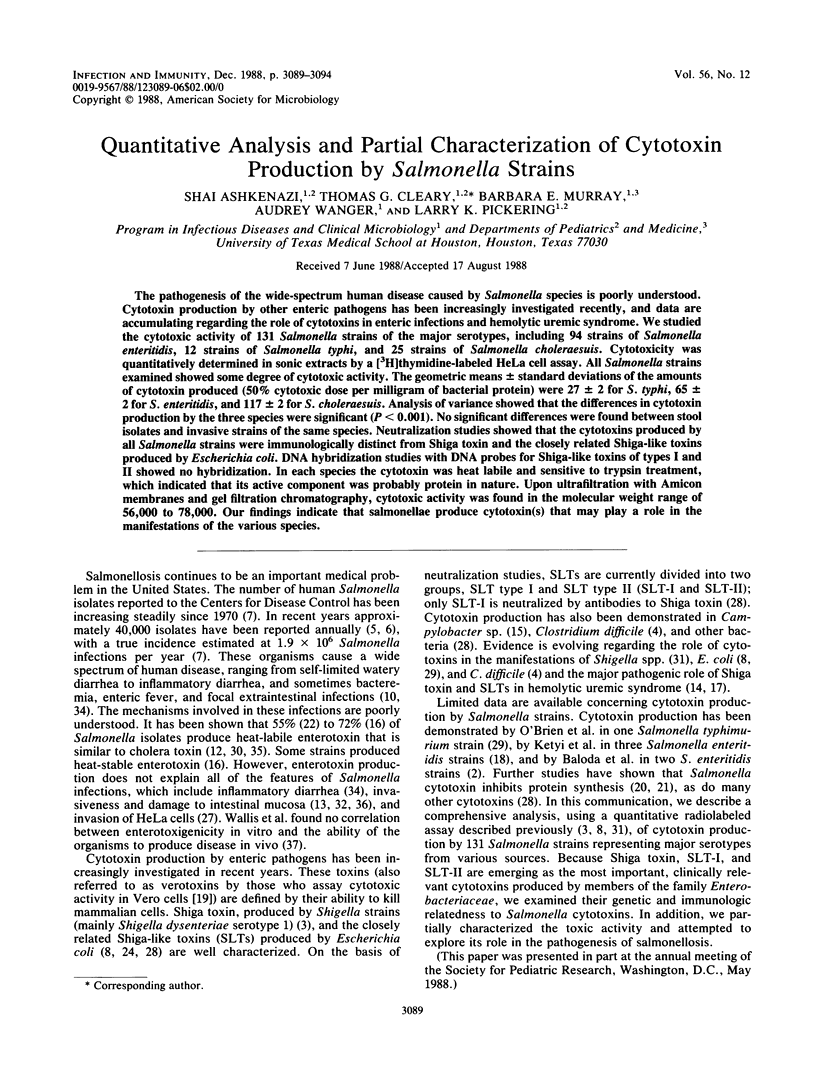
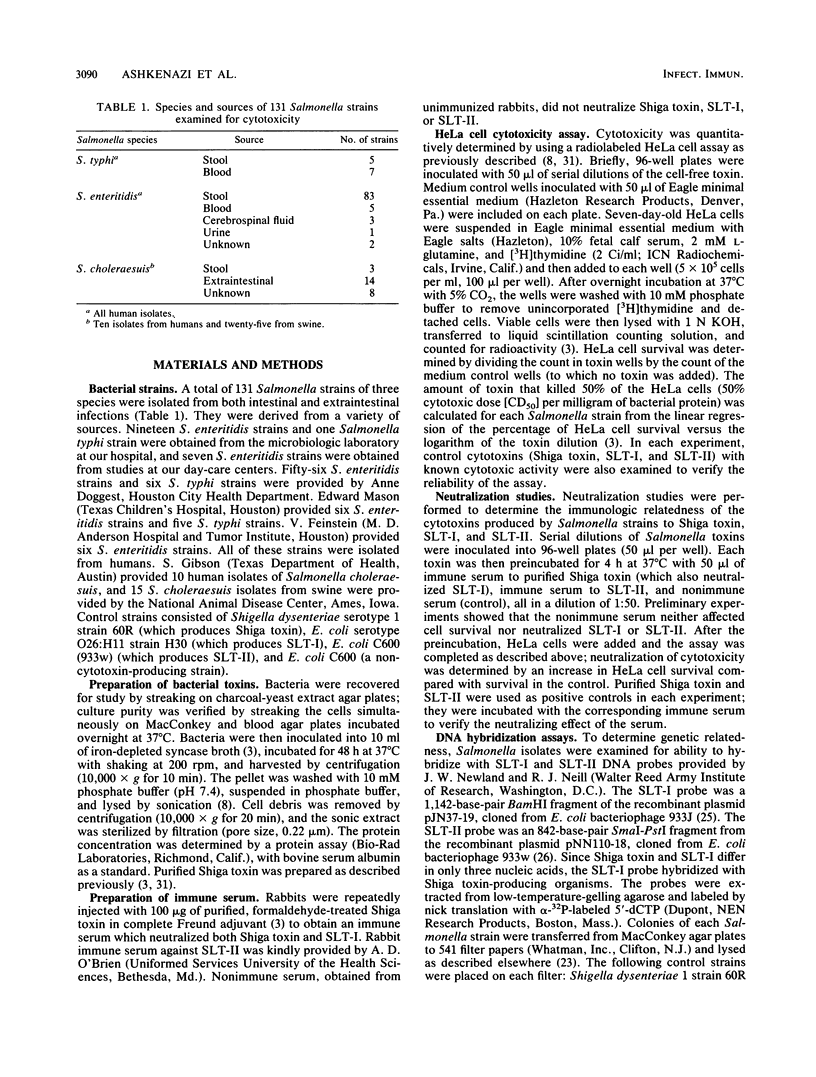
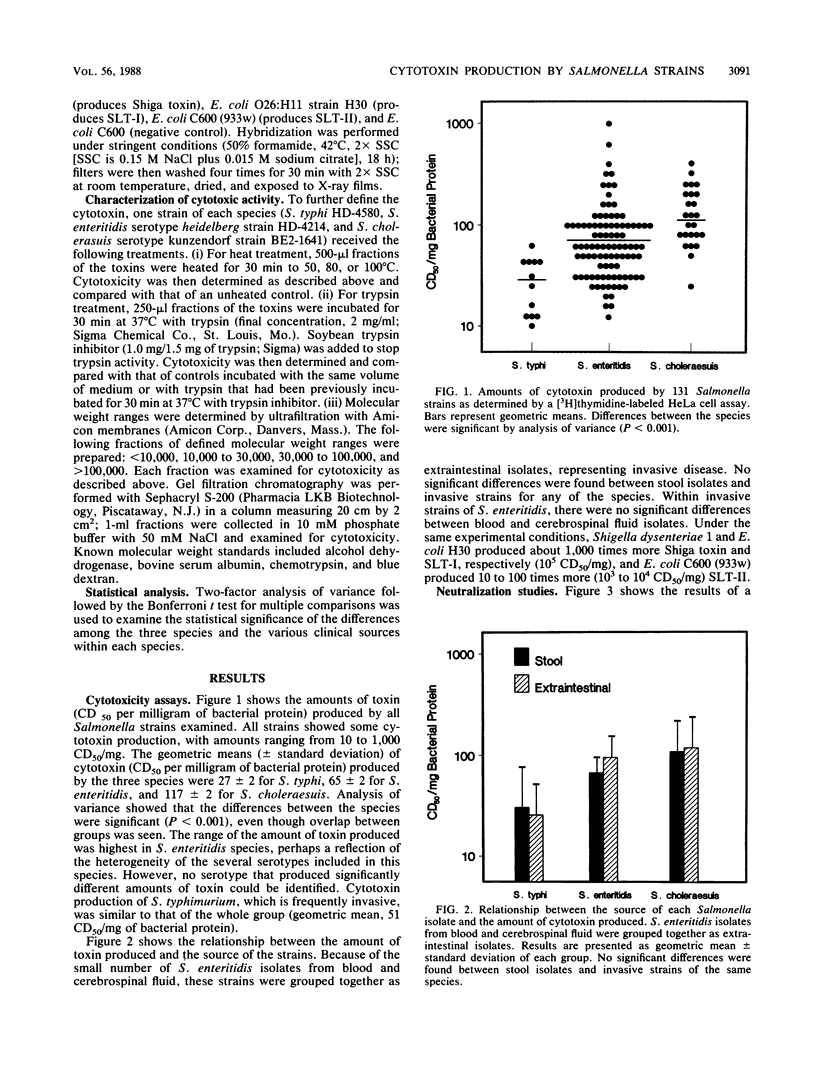
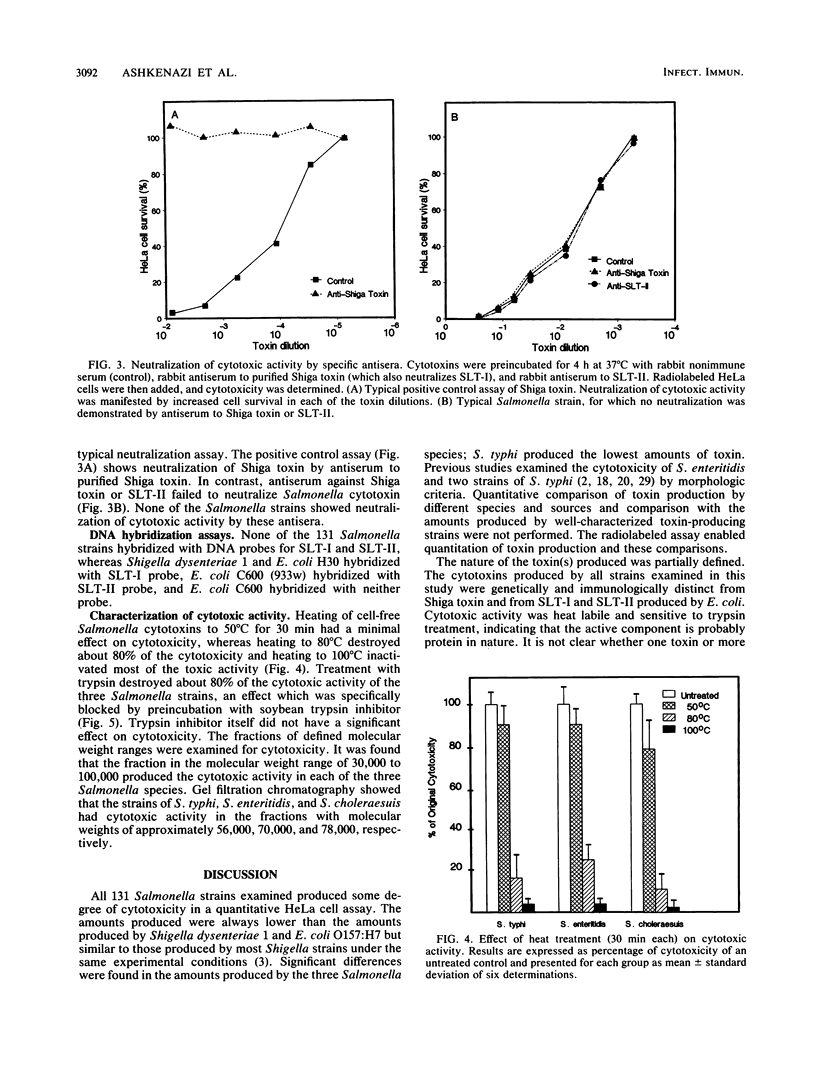
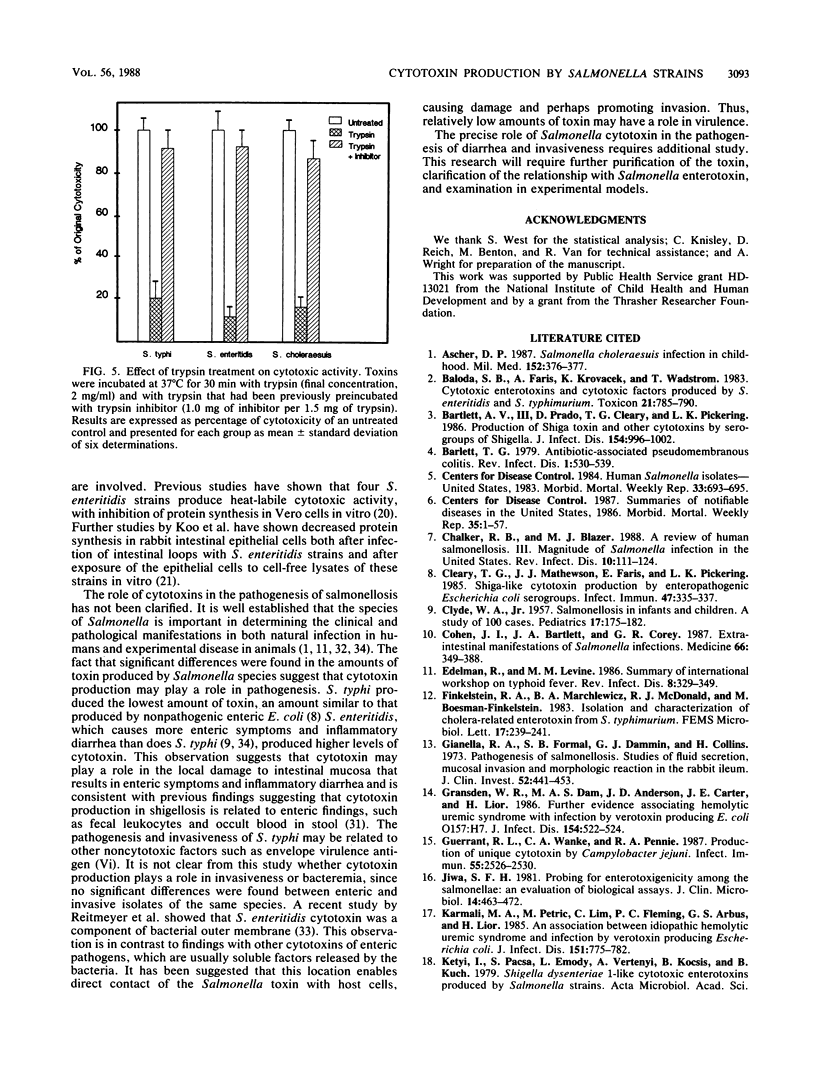
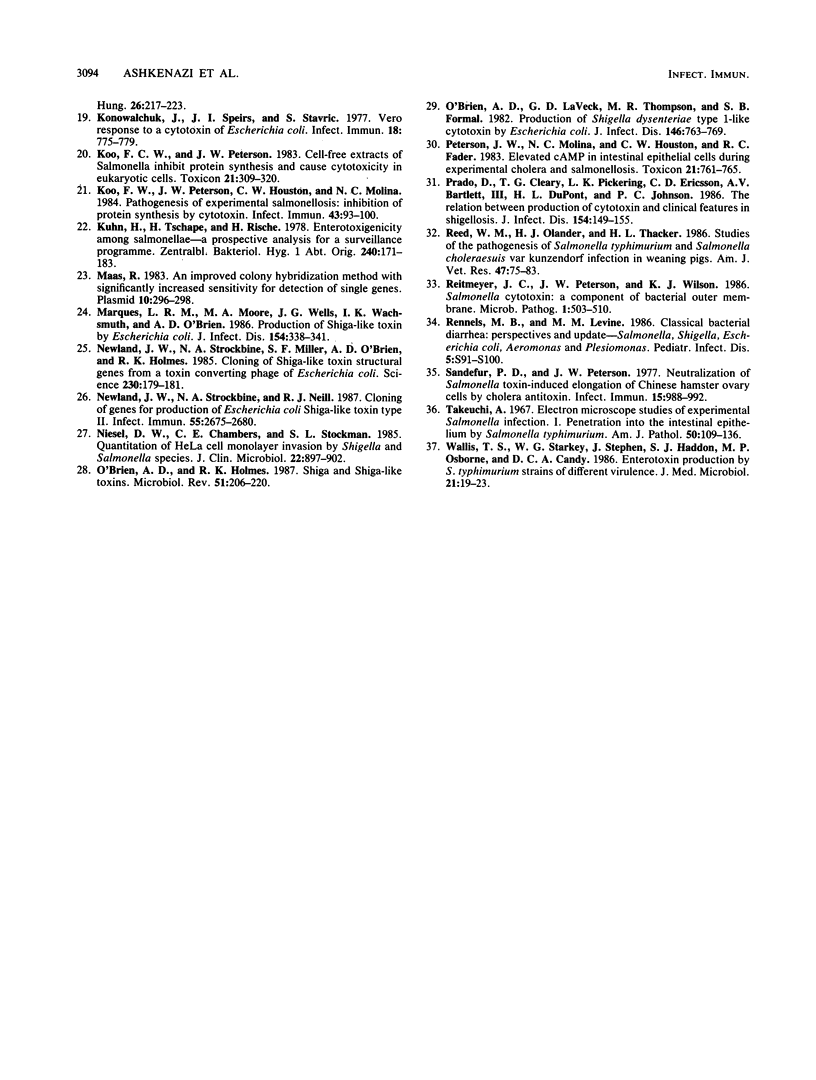
Selected References
These references are in PubMed. This may not be the complete list of references from this article.
- Ascher D. P. Salmonella cholerasuis infections in childhood. Mil Med. 1987 Jul;152(7):376–377. [PubMed] [Google Scholar]
- Baloda S. B., Faris A., Krovacek K., Wadström T. Cytotonic enterotoxins and cytotoxic factors produced by Salmonella enteritidis and Salmonella typhimurium. Toxicon. 1983;21(6):785–796. doi: 10.1016/0041-0101(83)90067-3. [DOI] [PubMed] [Google Scholar]
- Bartlett A. V., 3rd, Prado D., Cleary T. G., Pickering L. K. Production of Shiga toxin and other cytotoxins by serogroups of Shigella. J Infect Dis. 1986 Dec;154(6):996–1002. doi: 10.1093/infdis/154.6.996. [DOI] [PubMed] [Google Scholar]
- Bartlett J. G. Antibiotic-associated pseudomembranous colitis. Rev Infect Dis. 1979 May-Jun;1(3):530–539. doi: 10.1093/clinids/1.3.530. [DOI] [PubMed] [Google Scholar]
- CLYDE W. A., Jr Salmonellosis in infants and children; a study of 100 cases. Pediatrics. 1957 Feb;19(2):175–183. [PubMed] [Google Scholar]
- Chalker R. B., Blaser M. J. A review of human salmonellosis: III. Magnitude of Salmonella infection in the United States. Rev Infect Dis. 1988 Jan-Feb;10(1):111–124. doi: 10.1093/clinids/10.1.111. [DOI] [PubMed] [Google Scholar]
- Cleary T. G., Mathewson J. J., Faris E., Pickering L. K. Shiga-like cytotoxin production by enteropathogenic Escherichia coli serogroups. Infect Immun. 1985 Jan;47(1):335–337. doi: 10.1128/iai.47.1.335-337.1985. [DOI] [PMC free article] [PubMed] [Google Scholar]
- Cohen J. I., Bartlett J. A., Corey G. R. Extra-intestinal manifestations of salmonella infections. Medicine (Baltimore) 1987 Sep;66(5):349–388. doi: 10.1097/00005792-198709000-00003. [DOI] [PubMed] [Google Scholar]
- Edelman R., Levine M. M. Summary of an international workshop on typhoid fever. Rev Infect Dis. 1986 May-Jun;8(3):329–349. doi: 10.1093/clinids/8.3.329. [DOI] [PubMed] [Google Scholar]
- Giannella R. A., Formal S. B., Dammin G. J., Collins H. Pathogenesis of salmonellosis. Studies of fluid secretion, mucosal invasion, and morphologic reaction in the rabbit ileum. J Clin Invest. 1973 Feb;52(2):441–453. doi: 10.1172/JCI107201. [DOI] [PMC free article] [PubMed] [Google Scholar]
- Gransden W. R., Damm M. A., Anderson J. D., Carter J. E., Lior H. Further evidence associating hemolytic uremic syndrome with infection by Verotoxin-producing Escherichia coli O157:H7. J Infect Dis. 1986 Sep;154(3):522–524. doi: 10.1093/infdis/154.3.522. [DOI] [PubMed] [Google Scholar]
- Guerrant R. L., Wanke C. A., Pennie R. A., Barrett L. J., Lima A. A., O'Brien A. D. Production of a unique cytotoxin by Campylobacter jejuni. Infect Immun. 1987 Oct;55(10):2526–2530. doi: 10.1128/iai.55.10.2526-2530.1987. [DOI] [PMC free article] [PubMed] [Google Scholar]
- Jiwa S. F. Probing for enterotoxigenicity among the salmonellae: an evaluation of biological assays. J Clin Microbiol. 1981 Nov;14(5):463–472. doi: 10.1128/jcm.14.5.463-472.1981. [DOI] [PMC free article] [PubMed] [Google Scholar]
- Karmali M. A., Petric M., Lim C., Fleming P. C., Arbus G. S., Lior H. The association between idiopathic hemolytic uremic syndrome and infection by verotoxin-producing Escherichia coli. J Infect Dis. 1985 May;151(5):775–782. doi: 10.1093/infdis/151.5.775. [DOI] [PubMed] [Google Scholar]
- Konowalchuk J., Speirs J. I., Stavric S. Vero response to a cytotoxin of Escherichia coli. Infect Immun. 1977 Dec;18(3):775–779. doi: 10.1128/iai.18.3.775-779.1977. [DOI] [PMC free article] [PubMed] [Google Scholar]
- Koo F. C., Peterson J. W. Cell-free extracts of Salmonella inhibit protein synthesis and cause cytotoxicity in eukaryotic cells. Toxicon. 1983;21(2):309–320. doi: 10.1016/0041-0101(83)90016-8. [DOI] [PubMed] [Google Scholar]
- Koo F. C., Peterson J. W., Houston C. W., Molina N. C. Pathogenesis of experimental salmonellosis: inhibition of protein synthesis by cytotoxin. Infect Immun. 1984 Jan;43(1):93–100. doi: 10.1128/iai.43.1.93-100.1984. [DOI] [PMC free article] [PubMed] [Google Scholar]
- Kühn H., Tschäpe H., Rische H. Enterotoxigenicity among salmonellae--a prospective analysis for a surveillance programme. Zentralbl Bakteriol Orig A. 1978 Apr;240(2):171–183. [PubMed] [Google Scholar]
- Maas R. An improved colony hybridization method with significantly increased sensitivity for detection of single genes. Plasmid. 1983 Nov;10(3):296–298. doi: 10.1016/0147-619x(83)90045-8. [DOI] [PubMed] [Google Scholar]
- Marques L. R., Moore M. A., Wells J. G., Wachsmuth I. K., O'Brien A. D. Production of Shiga-like toxin by Escherichia coli. J Infect Dis. 1986 Aug;154(2):338–341. doi: 10.1093/infdis/154.2.338. [DOI] [PubMed] [Google Scholar]
- Newland J. W., Strockbine N. A., Miller S. F., O'Brien A. D., Holmes R. K. Cloning of Shiga-like toxin structural genes from a toxin converting phage of Escherichia coli. Science. 1985 Oct 11;230(4722):179–181. doi: 10.1126/science.2994228. [DOI] [PubMed] [Google Scholar]
- Newland J. W., Strockbine N. A., Neill R. J. Cloning of genes for production of Escherichia coli Shiga-like toxin type II. Infect Immun. 1987 Nov;55(11):2675–2680. doi: 10.1128/iai.55.11.2675-2680.1987. [DOI] [PMC free article] [PubMed] [Google Scholar]
- Niesel D. W., Chambers C. E., Stockman S. L. Quantitation of HeLa cell monolayer invasion by Shigella and Salmonella species. J Clin Microbiol. 1985 Dec;22(6):897–902. doi: 10.1128/jcm.22.6.897-902.1985. [DOI] [PMC free article] [PubMed] [Google Scholar]
- O'Brien A. D., Holmes R. K. Shiga and Shiga-like toxins. Microbiol Rev. 1987 Jun;51(2):206–220. doi: 10.1128/mr.51.2.206-220.1987. [DOI] [PMC free article] [PubMed] [Google Scholar]
- O'Brien A. D., LaVeck G. D., Thompson M. R., Formal S. B. Production of Shigella dysenteriae type 1-like cytotoxin by Escherichia coli. J Infect Dis. 1982 Dec;146(6):763–769. doi: 10.1093/infdis/146.6.763. [DOI] [PubMed] [Google Scholar]
- Peterson J. W., Molina N. C., Houston C. W., Fader R. C. Elevated cAMP in intestinal epithelial cells during experimental cholera and salmonellosis. Toxicon. 1983;21(6):761–775. doi: 10.1016/0041-0101(83)90065-x. [DOI] [PubMed] [Google Scholar]
- Prado D., Cleary T. G., Pickering L. K., Ericsson C. D., Bartlett A. V., 3rd, DuPont H. L., Johnson P. C. The relation between production of cytotoxin and clinical features in shigellosis. J Infect Dis. 1986 Jul;154(1):149–155. doi: 10.1093/infdis/154.1.149. [DOI] [PubMed] [Google Scholar]
- Reed W. M., Olander H. J., Thacker H. L. Studies on the pathogenesis of Salmonella typhimurium and Salmonella choleraesuis var kunzendorf infection in weanling pigs. Am J Vet Res. 1986 Jan;47(1):75–83. [PubMed] [Google Scholar]
- Reitmeyer J. C., Peterson J. W., Wilson K. J. Salmonella cytotoxin: a component of the bacterial outer membrane. Microb Pathog. 1986 Oct;1(5):503–510. doi: 10.1016/0882-4010(86)90012-4. [DOI] [PubMed] [Google Scholar]
- Rennels M. B., Levine M. M. Classical bacterial diarrhea: perspectives and update--Salmonella, Shigella, Escherichia coli, Aeromonas and Plesiomonas. Pediatr Infect Dis. 1986 Jan-Feb;5(1 Suppl):S91–100. [PubMed] [Google Scholar]
- Sandefur P. D., Peterson J. W. Neutralization of Salmonella toxin-induced elongation of Chinese hamster ovary cells by cholera antitoxin. Infect Immun. 1977 Mar;15(3):988–992. doi: 10.1128/iai.15.3.988-992.1977. [DOI] [PMC free article] [PubMed] [Google Scholar]
- Takeuchi A. Electron microscope studies of experimental Salmonella infection. I. Penetration into the intestinal epithelium by Salmonella typhimurium. Am J Pathol. 1967 Jan;50(1):109–136. [PMC free article] [PubMed] [Google Scholar]
- Wallis T. S., Starkey W. G., Stephen J., Haddon S. J., Osborne M. P., Candy D. C. Enterotoxin production by Salmonella typhimurium strains of different virulence. J Med Microbiol. 1986 Feb;21(1):19–23. doi: 10.1099/00222615-21-1-19. [DOI] [PubMed] [Google Scholar]


